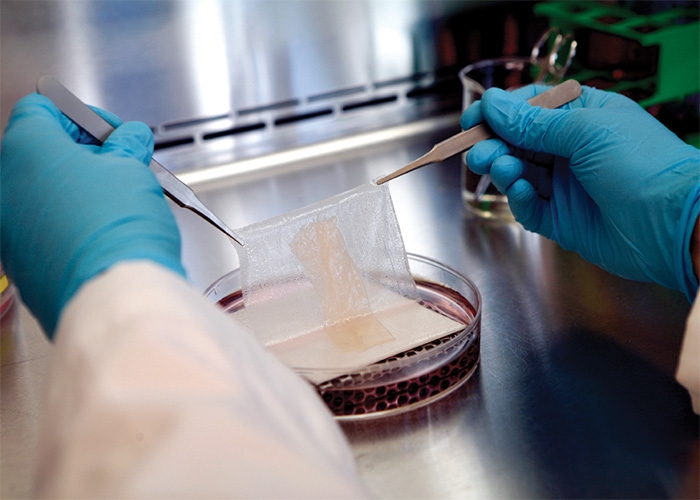Tissue Engineering: Transforming Healthcare Using Regenerative Medicine

Tissue engineering is a field of regenerative medicine that develops biological substitutes to restore, maintain or improve tissue function. It involves using a combination of cells, engineering materials and suitable biochemical factors aiming to grow new tissues and eventually whole organs. The goal of tissue engineering is to generate functional tissues and organs that can repair or replace those damaged by disease and injury or just simply aged.
Cells Used in Tissue Engineering
A variety of cells can be used in Tissue Engineering including stem cells, primary cells, cell lines and differentiated cells. Stem cells are preferred due to their ability to differentiate into specialized cell types. Mesenchymal stem cells can form bone, cartilage, fat, and muscle. Embryonic stem cells are pluripotent and have the highest potential to form any cell type. However, ethical and technical issues limit their use. Induced pluripotent stem cells generated from adult cells overcome these limitations but need further improvements. Differentiated cells like chondrocytes are also used for cartilage regeneration as they have limited potential for uncontrolled growth. Immune compatibility is an important consideration while choosing donor cells.
Biomaterials Used as Scaffolds
The type of biomaterial used as a scaffold plays a vital role in tissue engineering by supporting cell attachment, growth and tissue development. Natural biomaterials like collagen, fibrin and hyaluronic acid mimic extracellular matrix components but have limited mechanical strength and batch-to-batch variability. Synthetic biomaterials like polyglycolic acid, polylactic acid and polycaprolactone have consistent properties but lack cell binding sites. Composite scaffolds reinforced with ceramics, carbon nanotubes and other materials provide both biological and mechanical support. Dynamic scaffold designs that mimic body movements and respond to cues are also being developed.
Tissue Engineering Techniques
The key techniques in tissue engineering are scaffold-based and scaffold-free approaches. In scaffold-based approach, cells are seeded onto three-dimensional porous scaffolds. Factors like pore size, porosity and scaffold degradation influence new tissue regeneration. Scaffold-free techniques like self-assembly and 3D bioprinting generate tissue constructs using just cells, biomolecules and culture conditions without scaffolds. Bioreactor systems provide dynamic physiochemical environments to develop tissue constructs. Co-culture systems with multiple cell types and incorporation of vascular networks are being developed to achieve complex tissue structures. Advances in material sciences, stem cell technologies, bioimaging and 3D bioprinting have enabled multi-tissue and whole-organ fabrication for kidney, liver, heart and more.
Clinical Translation
Tissue engineering has made significant progress over the past years. Engineered skin, cartilage, bone and bladder substitutes have received market approval. Skin substitutes including cultured epidermal autografts and bilayered skin substitutes help treat diabetic foot ulcers, burns and wounds. Autologous chondrocyte implantation is a established treatment for cartilage repair in knees. Tissue-engineered grafts made from bone marrow-derived cells, growth factors and biomaterials enhance bone healing. Tissue-engineered bladder and urethral substitutes help treat conditions like spinal cord injury. More complex constructs for cardiovascular tissues, hepatic tissues and kidney are under clinical trials. Development of donor cell banks, vascularized constructs and scaled up automated manufacturing will help achieve commercialization and clinical translation of different tissue types. Overall, it provides an alternative to organ transplantation by creating functional living tissues.
tissue engineering has made significant progress in regenerating tissues and whole organs thereby offering solutions to treat damaged tissues and organ failures. Advancements in stem cell technologies, biomaterials, bioreactors and 3D bioprinting are revolutionizing the field. Successful clinical translation of skin, cartilage, bladder substitutes proves its huge potential. Although challenges remain in achieving vascularization, complex organ structures and scaled up production, it offers hope to address the rising organ shortage crisis. Future areas of research include developing functional tissues with established vascular networks mimicking native tissues, controlled immunogenicity of biomaterials and long term integration of engineered constructs. With continued multidisciplinary collaborations between engineers, biologists and clinicians, it promises to become a viable alternative to organ transplantation.
Author Bio:
Ravina Pandya,
Content Writer, has a strong foothold in the market research industry.
She specializes in writing well-researched articles from different industries, including food and beverages,
information and technology, healthcare, chemical and materials, etc. (https://www.linkedin.com/in/ravina-pandya-1a3984191)
Get More Insight @ Tissue Engineering
- Industry
- Art
- Causes
- Crafts
- Dance
- Drinks
- Film
- Fitness
- Food
- Games
- Gardening
- Health
- Home
- Literature
- Music
- Networking
- Other
- Party
- Religion
- Shopping
- Sports
- Theater
- Wellness
- News


